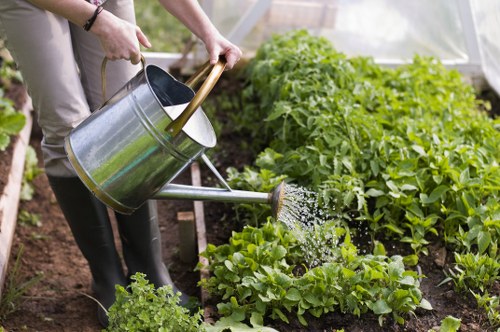Lawn Mowing in Gardening Gardener
Introduction to Lawn Mowing

Lawn mowing is a fundamental aspect of gardening, contributing significantly to the overall health and aesthetics of your garden. Regular mowing helps maintain the grass at an optimal height, promoting dense growth and reducing the presence of weeds.
For garden enthusiasts and professional gardeners, understanding the nuances of lawn mowing is essential. It not only enhances the visual appeal of your outdoor space but also plays a critical role in the ecosystem of your garden.
In this comprehensive guide, we will delve into the best practices, tools, and techniques for effective lawn mowing, ensuring your garden remains lush and vibrant throughout the seasons.
Benefits of Regular Lawn Mowing

Regular lawn mowing offers numerous benefits that extend beyond mere aesthetics. Some of the key advantages include:
- Weed Control: Mowing helps prevent the growth of unwanted weeds by cutting them before they can establish a strong root system.
- Grass Health: Frequent mowing ensures that the grass grows thick and healthy, as it stimulates the plants to produce more leaves.
- Prevent Pest Infestations: Shorter grass makes it harder for pests to hide, reducing the likelihood of infestations.
- Improved Appearance: A well-mowed lawn enhances the overall look of your garden, making it more inviting.
Choosing the Right Mowing Equipment

Selecting the appropriate lawn mowing equipment is crucial for achieving the best results. The type of mower you choose depends on various factors, including the size of your lawn, the type of grass, and your personal preferences.
Here are some common types of lawn mowers to consider:
- Push Mowers: Ideal for small to medium-sized lawns, push mowers are eco-friendly and require no fuel.
- Self-Propelled Mowers: These mowers are easier to maneuver, making them suitable for larger lawns or those with uneven terrain.
- Ride-On Mowers: Best for very large lawns, ride-on mowers offer efficiency and comfort during extended mowing sessions.
- Electric Mowers: Quiet and low-maintenance, electric mowers are a great choice for environmentally conscious gardeners.
Choosing the right mower can make a significant difference in the quality and ease of your lawn mowing experience.
Best Practices for Lawn Mowing

Adhering to best practices ensures that your lawn remains healthy and visually appealing. Here are some essential tips:
- Mowing Frequency: Generally, mowing once a week during the growing season is recommended. Adjust the frequency based on the growth rate of your grass.
- Optimal Height: Maintain your grass at a height of about 2.5 to 3 inches. Cutting too short can stress the grass, while leaving it too long may lead to thatch buildup.
- Sharp Blades: Ensure that your mower blades are sharp to make clean cuts, which promote faster healing and reduce disease risks.
- Mowing Pattern: Vary your mowing pattern to prevent soil compaction and encourage grass to grow in different directions.
Seasonal Lawn Mowing Tips

Different seasons require different lawn mowing strategies to accommodate the growth patterns and environmental conditions:
Spring
As the grass begins to grow actively, it's important to mow it regularly to encourage strong roots. Avoid cutting more than one-third of the grass height at a time.
Summer
During the hot months, maintain a slightly higher mowing height to provide shade to the roots, conserving moisture and reducing heat stress.
Autumn
As growth slows, continue regular mowing until the grass stops growing. Raking leaves regularly can prevent them from suffocating the lawn.
Winter
In colder climates, lawn mowing typically pauses during winter. However, removing debris and preparing your lawn for the upcoming growing season is essential.
Eco-Friendly Lawn Mowing Practices
Embracing eco-friendly practices not only benefits the environment but also promotes a healthier lawn:
- Mulching Mowers: These mowers finely chop the grass clippings, returning nutrients to the soil and reducing the need for fertilizers.
- Electric Mowers: Opting for electric-powered mowers reduces carbon emissions and noise pollution.
- Water Conservation: Mow your lawn during cooler parts of the day to minimize water evaporation and maintain soil moisture.
- Natural Pest Control: Use organic methods to manage pests, avoiding harmful chemicals that can damage the grass and surrounding flora.
Common Lawn Mowing Mistakes to Avoid
To maintain a healthy and vibrant lawn, it's important to steer clear of common mistakes:
- Mowing Wet Grass: Mowing when the grass is wet can lead to uneven cuts and promote disease spread.
- Cutting Too Short: Removing more than one-third of the grass height can shock the lawn, making it susceptible to pests and diseases.
- Ignoring Blade Maintenance: Dull mower blades tear the grass rather than cutting it cleanly, leading to poor growth and increased vulnerability.
- Skipping Mowing Sessions: Allowing the grass to grow too long can make mowing more difficult and harm the overall health of the lawn.
Advanced Lawn Mowing Techniques
For those looking to take their lawn mowing skills to the next level, consider these advanced techniques:
Scalping
Temporary scalping can be useful in certain situations, such as removing excess thatch. However, it should be done sparingly to avoid damaging the grass.
Striping
Creating stripes by adjusting the mower's direction or using a striping kit adds a professional touch to your lawn's appearance.
Variable Speed Settings
Utilizing variable speed settings on your mower can help navigate different terrains and adapt to various mowing conditions effectively.
Edge Trimming
Maintaining clean edges along paths, flower beds, and driveways gives your lawn a well-manicured look. Using a string trimmer or edging tool can achieve precise lines.
Choosing the Right Time for Lawn Mowing
The timing of your lawn mowing sessions can significantly impact the health of your grass:
- Time of Day: Early morning or late afternoon are the best times to mow, as temperatures are cooler and grass is less stressed.
- Grass Growth: Ensure the grass has dried from any dew or rain to prevent clumping and uneven cuts.
- Seasonal Considerations: Adjust your mowing schedule based on seasonal growth patterns to maintain consistency.
By timing your mowing sessions appropriately, you can enhance the effectiveness of your lawn care routine.
Maintaining Your Lawn Mower
Proper maintenance of your lawn mower is essential for ensuring its longevity and performance:
Regular Cleaning
After each mowing session, clean the mower to remove grass clippings and debris, preventing build-up that can impair functionality.
Blade Sharpening
Sharpen the mower blades at least once a season to maintain clean cutting edges, which promotes healthier grass growth.
Engine Care
For gas-powered mowers, regularly check and change the engine oil as recommended. For electric mowers, ensure the battery is charged and the cords are in good condition.
Inspecting Parts
Periodically inspect all parts of the mower for signs of wear or damage, replacing components as needed to maintain optimal performance.
Integrating Lawn Mowing with Overall Garden Care
Lawn mowing is just one element of comprehensive garden maintenance. Integrating it with other practices ensures a harmonious and thriving outdoor space:
- Watering: Establish a consistent watering schedule that complements your mowing routine.
- Fertilizing: Apply appropriate fertilizers to supply essential nutrients, especially after mowing.
- Pest Management: Monitor for pests regularly and address issues promptly using sustainable methods.
- Soil Health: Test and amend your soil as necessary to provide a fertile environment for your grass.
A holistic approach to garden care enhances the effectiveness of each individual practice, including lawn mowing.
Sustainable Lawn Mowing Practices
Embracing sustainability in your lawn mowing practices contributes to environmental conservation and long-term lawn health:
Grasscycling
Instead of bagging grass clippings, allow them to decompose on the lawn. This recycles nutrients and reduces the need for additional fertilizers.
Using Renewable Energy
Consider electric or solar-powered mowers to minimize your carbon footprint and reliance on fossil fuels.
Organic Maintenance
Opt for organic fertilizers and pest control methods to maintain a chemical-free garden environment.
Conserving Water
Implementing efficient watering techniques, such as drip irrigation or rainwater harvesting, ensures water is used responsibly.
Common Questions About Lawn Mowing
How Often Should I Mow My Lawn?
The frequency of mowing depends on the grass type and growth rate. Typically, mowing once a week during the peak growing season is ideal.
What is the Best Height to Cut Grass?
Maintaining grass at a height of 2.5 to 3 inches strikes a balance between aesthetics and lawn health.
Should I Mow When the Grass is Wet?
It's best to mow when the grass is dry to achieve clean cuts and prevent clumping, which can lead to fungal diseases.
How Do I Prevent My Lawn from Becoming Weedy?
Regular mowing, proper watering, and fertilizing create a thick, healthy lawn that naturally resists weed infiltration.
Conclusion
Lawn mowing is a vital component of effective gardening, contributing to both the beauty and health of your outdoor space. By adhering to best practices, selecting the right equipment, and embracing sustainable methods, you can maintain a vibrant and resilient lawn.
Whether you're a seasoned gardener or a novice, understanding the intricacies of lawn mowing empowers you to create a lush, inviting garden that stands the test of time.
Ready to transform your lawn? Contact us today to learn more about our professional lawn mowing services and take the first step towards a greener, healthier garden.



